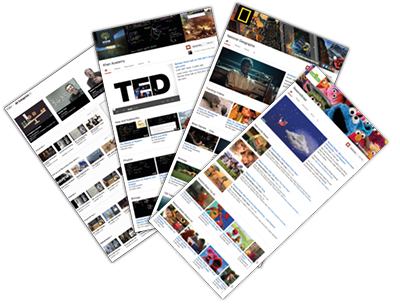 YouTube EDU started as a project at Google but in just three years it has grown to a fully-fledged portal. Dedicated solely to education-related videos, it currently offers some 850,000 of these, from over 1,000 channels. With the exponential increase in the number of videos available on YouTube — 100 hours’ worth are uploaded every minute — YouTube EDU is becoming an increasingly important educational provider.
YouTube EDU started as a project at Google but in just three years it has grown to a fully-fledged portal. Dedicated solely to education-related videos, it currently offers some 850,000 of these, from over 1,000 channels. With the exponential increase in the number of videos available on YouTube — 100 hours’ worth are uploaded every minute — YouTube EDU is becoming an increasingly important educational provider.
EduNation had the chance to interview Ms Angela Lin, Head of YouTube EDU, via video at its Singapore office.
“The big challenge for a lot of students and for teachers is the difficulty of finding educational content so that’s how YouTube EDU came about. When we began it was actually focused on university content because that was the easiest to obtain. However, now there are three major categories: K-12, higher education, and lifelong learning,” said Ms Lin.
The first category spans nursery to high school education with content providers like Sesame Street and Khan Academy while the second often includes lectures or even whole courses from universities. The last is the most diverse in terms of the types of content it carries, including, as it does, TED talks and channels like BigThink, where experts and speakers share their knowledge with the world. But the most popular content, surprisingly, is aimed at pre-schoolers.
“I would say that in terms of category the most popular type of content is the pre-K videos aimed at young children. Channels like Sesame Street, Super Simple Songs, Kids TV123 and so on. That specific segment is really popular because even though YouTube is geared towards those aged 13 and above, parents are finding videos and shows from their own childhood that they want to share with their children. Programmes like Sesame Street have been favourites with every generation.”
Outside of the pre-K demographic popularity of YouTube videos, another major area of interest is languages. A lot of people are learning to pick up second and third languages. According to Ms Lin, one Chicago public school didn’t have local teachers who spoke Arabic, and so they built their curriculum around the YouTube channel of a woman based in London who teaches Arabic. The students used her videos and even had a video conference with her. “Videos therefore become quite powerful as a learning tool. They do not just complement the classrooms that exist today but also fill gaps where there aren’t any teachers with the right skills,” elaborated Ms Lin.
The next big thing in online education is Massive Online Open Course (MOOC) and YouTube EDU is already there. Two MOOC giants —EdX and Udacity, are already driving their content through YouTube. Next up, it wants Coursera — which hosts content on their own servers — to come on board. “These massive open online courses see YouTube as a great partner because we reach over a billion unique viewers a month. They can upload their content once and have access to it all from multiple devices across multiple territories and this isn’t something that universities were able to do in the past without having to invest in significant infrastructural resources,” said Ms Lin.
The reasons the universities are willing to do this, Ms Lin said, are simple. “The primary motive for these universities is that their mission is to educate. So ultimately their mission is to share their knowledge and research with the world. Traditionally, this has happened in one of two ways. One is through classes on campus with professors teaching their students, and the second is through publishing papers. Nowadays with sites like YouTube and open courseware it’s possible for them to go beyond that to fulfil their mission to an even greater degree by providing the lectures, research and content through video. So I think that’s first and foremost what universities tell me is their main motivation — it’s to fulfil their main mission of educating and then being able to do it beyond their physical campuses.
“Also, some professors are interested in testing out certain types of ideas. They want to instigate a conversation and traditionally they could only do so through academic conferences and papers and having to debate and discuss their research that way. But now, through video and social media, they can have more immediate feedback and engage with a global audience. If you’re in a small university in Ireland, say, and you’re researching some topic, you might not have been able to share information as readily with another researcher halfway across the world before, but now through technology in general and videos in particular you can,” concluded Ms Lin.
As the world becomes smaller and increasingly integrated, we can expect YouTube to be at the forefront of creating the classroom of tomorrow.
|